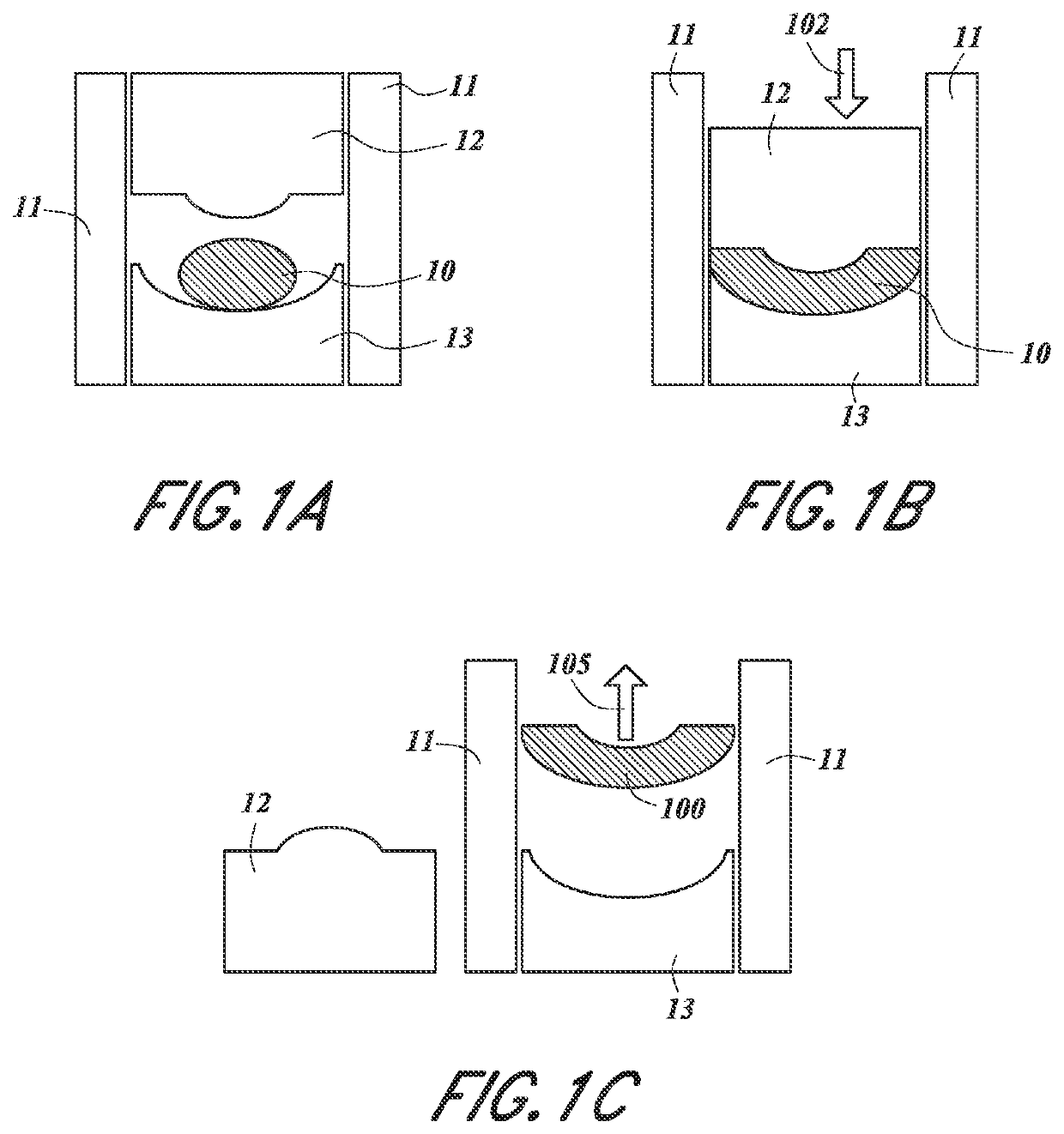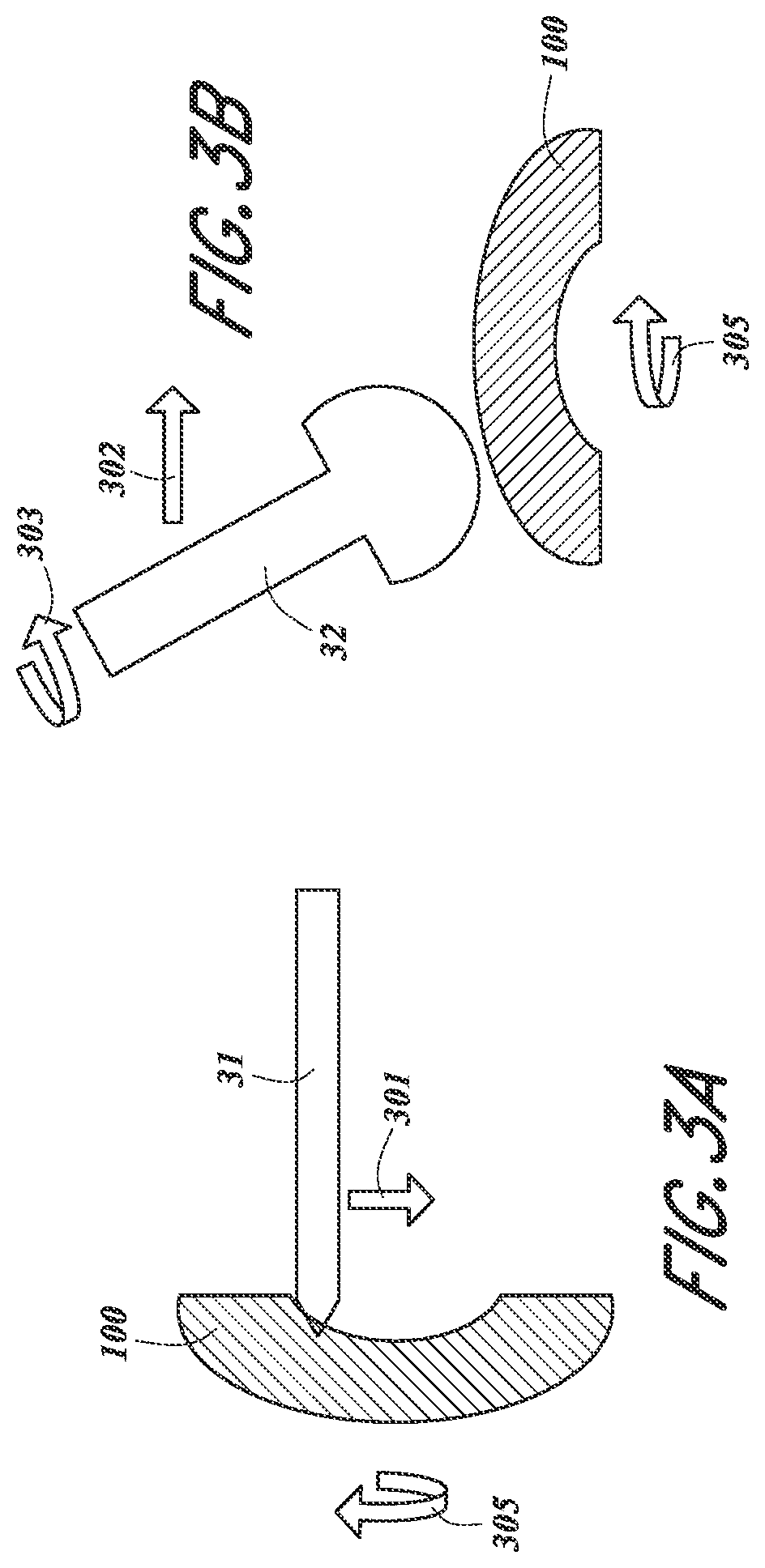Systems and methods for molding chalcogenide glass into a near-net shaped part
- Summary
- Abstract
- Description
- Claims
- Application Information
AI Technical Summary
Benefits of technology
Problems solved by technology
Method used
Image
Examples
example precision mold
[0023]Molds for precision glass molding (PGM) may be manufactured using precision diamond turning or precision diamond grinding to generate the optical surface. The molded component replicates the surface of the mold, and therefore any defects on the molds will be replicated on the component itself. High precision in the mold dimensions results in forming a near-net shaped optical element that needs a small or sufficiently reduced amount of diamond-turning to form the final shaped optical product. The cavity formed by the mold may be slightly larger (e.g., within 105%) of the volume of the near-net shaped lens. The use of smaller molds, i.e., molds that form inner cavities that are closer (e.g., within 105%) to the volume of the near-net shaped lens may increase precision and reduce waste in the subsequent diamond-turning. Carbide or ceramic tooling may be used in PGM because of the high temperatures involved during processing. Carbide or ceramic molds may be manufactured by precisi...
example glass
Composition
[0025]Although there are many plastic materials to choose from for the visible spectrum, these polymers generally absorb longwave infrared light, and are therefore generally inadequate for thermal applications operating in the LWIR (8-12 μm) band. Although crystalline materials such as Ge, ZnS, and ZnSe transmit well in the LWIR band, they are generally not moldable and therefore they are not well-suited to high-volume, low-cost production.
[0026]In some embodiments, chalcogenide materials may be used for LWIR lens applications. The moldability of chalcogenide glass qualifies it for the high-volume demand of commercial longwave IR applications. Although precision glass molding (PGM) of chalcogenides may be used to manufacture low cost optics in the longwave infrared, some of the most commonly used chalcogenides in PGM to date have been compositions containing germanium, such as Ge28Sb12Se60 and Ge22As20Se58. Another germanium-free composition is As40Se60.
[0027]Chalcogenide...
example molding
Process
[0029]Precision glass molding is a compression molding process (as opposed to, for example, injection molding) capable of transferring high-quality aspheric shapes from a precision mold set into the optical lens being formed. This technology has the distinct advantage of enabling low cost optical lenses for high volume applications, while maintaining the high quality of aspheric optical surface profiles and utilizing the inherent advantages of glass materials.
[0030]Precision glass molding, PGM, is a manufacturing process used to make high quality lenses and optical components. The general nature of the process is the compression molding of glass preforms at high temperature under highly controlled conditions. A brief summary of the PGM process follows. The PGM process starts with the manufacturing of tooling designed specifically for the product to be manufactured. This tooling can include, for example, a top mold, a bottom mold and ancillary tooling to form the outside diame...
PUM
| Property | Measurement | Unit |
|---|---|---|
| Length | aaaaa | aaaaa |
| Fraction | aaaaa | aaaaa |
| Fraction | aaaaa | aaaaa |
Abstract
Description
Claims
Application Information
 Login to View More
Login to View More - R&D
- Intellectual Property
- Life Sciences
- Materials
- Tech Scout
- Unparalleled Data Quality
- Higher Quality Content
- 60% Fewer Hallucinations
Browse by: Latest US Patents, China's latest patents, Technical Efficacy Thesaurus, Application Domain, Technology Topic, Popular Technical Reports.
© 2025 PatSnap. All rights reserved.Legal|Privacy policy|Modern Slavery Act Transparency Statement|Sitemap|About US| Contact US: help@patsnap.com



